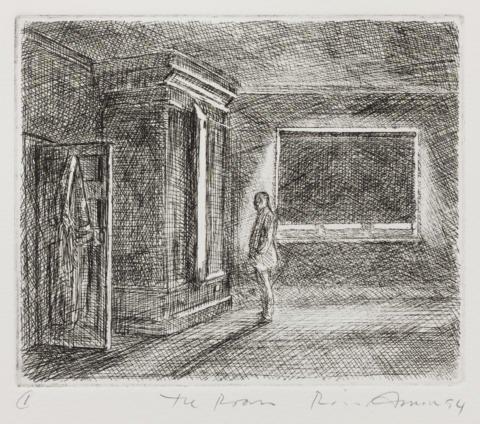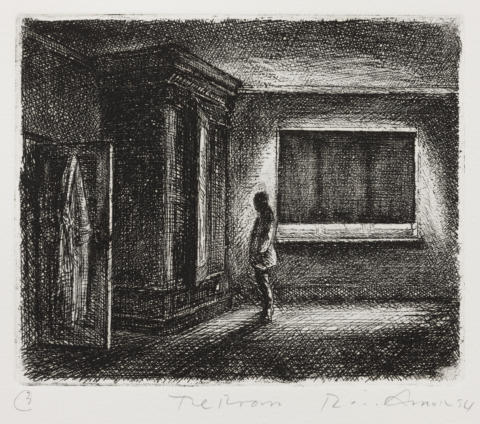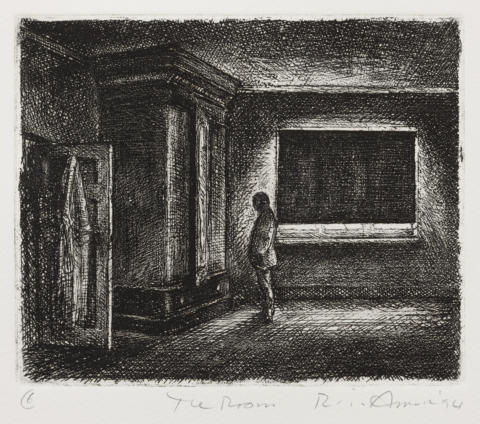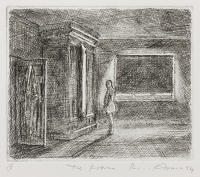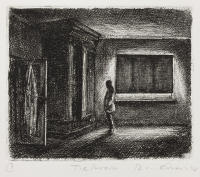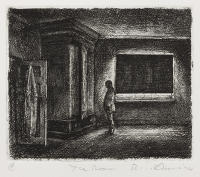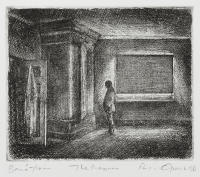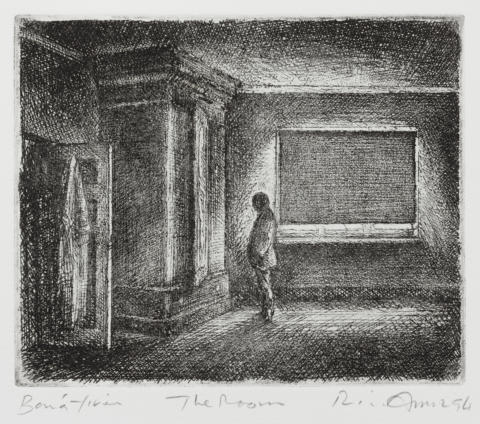
Etching. A man stands in left profile, with his hands in his pockets, in a room that is empty but for a large wardrobe at the left, its door ajar. The man faces it, unmoving. Behind him is a window, with its blind drawn but with daylight seeping through. Another human presence is suggested by the garment hanging on the open door at left. Most areas of the composition are covered with a dense mesh of etched cross-hatching, with the effects of light having been obtained through burnishing.
The light area on the ceiling has been extended and the two vertical beams seen through the blind are now thinner. The dark shadow below the window has been lightened through burnishing.
The wardrobe has been burnished lightly, as has the floor. The gap created by the open wardrobe door appears now as a strong, dark vertical.
The plate has been extensively burnished. The blind is again a flat area, with the window divisions no longer visible through it. There are three variant impressions of this state.
- Catalogue Number
- E.086
- Title and Date
- The room 1994
- Description of Featured Image
- A besuited man stands in left profile, with his hands in his pockets, in a room that is empty but for a large wardrobe at the left, its door ajar. The man faces it, unmoving. Behind him is a window, with its blind drawn but with daylight seeping through. Another human presence is suggested by the garment hanging on the open door at left.
- Where Made
- Alphington, Melbourne
- Medium Category and Technique
- Intaglio Print: Etching, burnishing and roulette on copper
- Support
- Wove paper. Identified papers: Arches paper with watermark: ‘ARCHES / FRANCE’ with infinity symbol; BFK Rives paper with watermark: ‘BFK RIVES / FRANCE’ with infinity symbol.
- Dimensions
-
Image size: 143 x 173 mm
Matrix size: 143 x 173 mm - Artist’s Record Number
- RAE.83
- Printer(s) and Workshop(s)
- All impressions printed by Rick Amor in his Alphington studio.
- Summary Edition Information
- Seven states. Nominal edition of ten, but only four impressions printed and numbered, 1994.
- Exhibitions
- Niagara Galleries 1994: Niagara Galleries, Richmond (Melbourne), Rick Amor, 20 September – 15 October 1994, no. 29, ed. 1/10.
- Niagara Galleries at IWOP 1997: Niagara Galleries at the International Works on Paper Fair, Mitchell Galleries, State Library of New South Wales, Sydney, 17–20 July 1997, no. 20 (no edition number cited).
- Literature
- For an analysis and interpretation of the painting The room (memory), 1994, see Gary Catalano, The Solitary Watcher: Rick Amor and His Art, Melbourne University Press, Carlton South, Victoria, 2001, pp. 145–7, illus. p. 146 (b&w).
- Collections
- State Library of Victoria, Melbourne: six state impressions, numbered 1 through 6; bon à tirer impression; AP II.
- Comment
The room depicted here is the bedroom in Amor’s newly purchased and freshly painted house in the Melbourne suburb of Alphington, not long after he and his partner, the artist Meg Williams, had moved in, in April 1994.
The presence of the Hitchcockian figure establishes immediately an atmosphere of mystery, at the heart of which is an exploration of the function of light in revealing subtle degrees of darkness and in evoking a perplexing mood. From the technical point of view, Amor has approached this etching almost as though it were a mezzotint, with the burnisher being used as a tool for creating and manipulating light. The main changes in detail through the progression of seven states focused on the source of illumination: the window. The blank blind of the first state was transformed in the second into a blind that allowed the tripartite structure of the window to show through. By the final state, the blind had returned to its original blankness. This starkness contributes to the sense of anonymity, of unsettling emptiness, in the image.
E.086 served as the model for a painting, also made in 1994, titled The room (memory) (Catalano 2001). This work, however, shows the room without a human presence. Catalano (2001) sees the painting as having a ‘massive poetic charge’ – as offering a clear example of Amor’s powers of suggestion and evocation. This is also true of the etching.
E.086 is the first print that Amor made and printed in his Alphington studio.
- Keywords
- Building, Figure – male, Interior, Man
- URL
- https://catalogue.rickamor.com.au/works/intaglio/the-room-2/
Record last updated 15/02/2021
